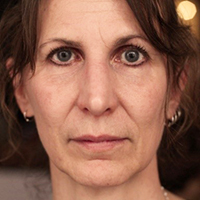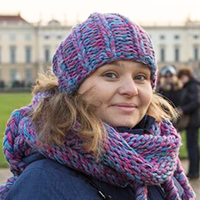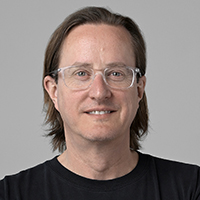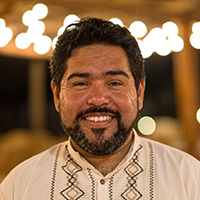By Janet Biggs, Agnieszka Międlar, Joey Orr, and Daniel Tapia Takaki
Applied mathematics occasionally manifests in unexpected, beautiful ways. One such example is the collaborative Collective Entanglements project, which is the physical culmination of an exciting journey of art, math, and science. In 2016, the Spencer Museum of Art at the University of Kansas (KU) secured funding for its new Arts Research Integration (ARI) program, which connects artists with high-level research projects in the sciences and humanities to promote interdisciplinary practices, generate an effective dialogue about subjects that directly impact daily life, and appeal to the general public. As per the Spencer Museum’s website, the ARI program recognizes “that the creation of art is a research methodology in its own right, and one that has much to contribute to the study of our world.” Joey Orr became the program’s first Curator for Research the following year, and high-energy nuclear physicist Daniel Tapia Takaki of KU was later appointed as an ARI Faculty Fellow. Tapia Takaki then recruited mathematician Agnieszka Międlar (now at Virginia Tech) as another ARI Faculty Fellow, while Orr contacted New York-based artist Janet Biggs — whose deep experience with interdisciplinary teamwork and familiarity with the European Organization for Nuclear Research (CERN) made her an especially valuable asset.
In 2020, the artist, physicist, mathematician, and museum curator began to meet regularly via Zoom to discuss potential directions for their atypical partnership, and a long-term collaboration was born. Our joint efforts resulted in the Collective Entanglements project, which utilizes time-based media to explore critical questions in high-energy physics and applies innovative mathematical methods to the production of video and performance. In April 2022, Collective Entanglements unveiled its inaugural public programming, which featured keynote talks, panels led by graduate students, and comprehensive roundtable dialogues. Subsequent exhibitions have expanded upon the themes of the project, and additional showcases are currently in preparation. Throughout this endeavor, we questioned the meanings of “fundamental” and “time” and asked ourselves questions like What is art? Is mathematics an art? and Can physics create art? But most importantly, we explored these questions together.
Figure 1. The multimedia livestreamed performance of Singular Value Decomposition—developed in 2021 by artist Janet Biggs, mathematician Agnieszka Międlar, and physicist Daniel Tapia Takaki—featured music and dance interpretations by multiple artists, including violinist Earl Maneein (pictured here). Photo courtesy of Janet Biggs.
Collaborative productions present interesting challenges in the integration of multidisciplinary research methodologies, as each discipline brings its own language and structure. Can cross-disciplinary collaboration be generative and substantive for every contributing field while still furthering scientific discovery? Early on, Biggs decided to work
collectively with Międlar and Tapia Takaki rather than create an independent piece of art; no other team in ARI’s history had ever undertaken such a challenge. She emphasized the importance of joint conversations to generate work based on everyone’s expertise and substantively contribute to each respective field. While some collectives opt to use another discipline’s research as an illustrative communication tool or inspiration for personal production, such approaches discount the transformative possibilities of complex shared research and experimentation.
As a nuclear physicist, Tapia Takaki intended to investigate fundamental questions about the initial state of protons and ions at high energies. While he hoped to explore quantum mechanics in new ways that extended beyond the restricted conditions in nature that often draw physicists’ focus, he also remained open to novel queries and approaches. Because large fundamental questions cannot be properly addressed in a vacuum, collaborative projects are immensely valuable for physics research; all scientists must also explore their work from unique perspectives and challenge themselves to study areas that they might otherwise ignore.
As our conversations began, each team member explained their individual work and research questions. We then took turns describing what we had heard each other say, which served as an exercise in listening, trust building, and vocabulary sorting. Although the collective had its inaugural joint public presentation during the 2020 National Conference of the Alliance for the Arts in Research Universities (a2ru), it was nearly a year before we were ready to embark on our first true experiment: a livestreamed performance titled Singular Value Decomposition that was presented by Cristin Tierney Gallery at Onassis ONX Studio in New York City (see Figure 1).
Figure 2. Artist Janet Biggs, mathematician Agnieszka Międlar, and physicist Daniel Tapia Takaki debuted the Collective Entanglements exhibition at the University of Kansas’ Spencer Museum of Art in 2022. The experience included a six-channel video installation with sound, as well as interactive whiteboards for visitors. Photo by Ryan Waggoner © Spencer Museum of Art.
Installations and performances were integral components of our research process, and risk-taking remained at the forefront of our investigations. As such, we ran our
culminating Collective Entanglements exhibition—installed in KU’s 3,000-square-foot Beren Center auditorium—as an experiment. The exhibition featured an immersive, multi-channel, synchronized video installation (see Figure 2) and interactive whiteboards that captured visitor data. Six screens surrounded a central column, inviting viewers to move around the installation and observe imagery that was inspired by the emergent phenomenon of time. The interactive whiteboards, panels, and lectures by visiting scholars Roger Malina (University of Texas at Dallas) and Tim Davis (Texas A&M University) initiated a dialogue between various communities and the public about the role of art-based research, art in science, and science in art. These conversations exposed misinterpretations and conflicting understandings of shared language; illuminated unfamiliar terms, concepts, and theories; removed hesitancies; and ultimately encouraged clear communication across disciplines. While the exhibition at KU has concluded,
Collective Entanglements has since been presented at the Sarasota Art Museum of Ringling College in Sarasota, Fl., and is under preparation for a future showing in Virginia.
A significant component of Collective Entanglements is the singular value decomposition (SVD): a well-established matrix analysis tool [5] that allows physicists to understand phenomena that were not clearly captured by CERN’s Large Hadron Collider (LHC). By distinguishing signals from background noise and assembling many instances of low-rank signals, we reconstructed a state prior to the LHC’s captured event, i.e., the initial state. We combined time-based media like video and performance with novel numerical linear algebra techniques—such as the higher-order SVD (HOSVD) [2] for tensor-train structured data [3]—in order to consider the probability of sequences and their potential initial states and ultimately produce relevant video and performance pieces. Manipulating video files in MATLAB also permitted us to explore related aspects of high-energy physics and quantum mechanics.
Figure 3. In 2022, the Collective Entanglements exhibition at the University of Kansas’ Spencer Museum of Art—created by artist Janet Biggs, mathematician Agnieszka Międlar, and physicist Daniel Tapia Takaki—featured videos that were altered with numerical linear algebra techniques, such as the higher-order singular value decomposition. Photo by Ryan Waggoner © Spencer Museum of Art.
The
Collective Entanglements six-channel, high-definition video and sound installation raised many additional questions. In one portion of the work, we utilized tensor-train decomposition [1] and applied a HOSVD to a video to obtain a radically different effect. While the SVD effectively introduced data as both a material and formal element of the artwork itself, the additional dimensions in this part of the installation pertained to channel and time. This alteration, which had a “thickening” effect on the images (see Figure 3), raised important questions about phenomena that were physically present but no longer visually represented [4].
Although artistic practice as a fundable academic research category is beginning to grow, the coalescence of visual arts with other disciplines to address today’s global problems is still in its infancy. Since the Spencer Museum of Art is embedded within a university, the ARI program is an active participant in the school’s research ecology at the level of question formation and research design. ARI also views artistic practice as its own particular type of research method with its own history, just like any other discipline; conversely, however, artistic endeavors often lead with practice (which then gives rise to questions and theories), rather than relying on more traditional scientific theory testing.
By working beyond the confines of any one particular discipline, scientists and artists can practice fluency and criticality in the context of their own subjects. They may find reasons to question assumptions instead of simply repeating them, which can reveal new insights and expose unacknowledged prejudices from a field’s historical development. But interdisciplinary collaboration is a long process, and individuals should be prepared to spend time building trust and collegiality beyond their own disciplinary homes. As real-world challenges become more complex and increasingly embedded in larger issues like social justice and global human rights, it is critical that scientists expand the nuance and fluency of their knowledge practices.
References
[1] Al Daas, H., Ballard, G., Cazeaux, P., Hallman, E., Międlar, A., Pasha, M., …, Saibaba, A.K. (2023). Randomized algorithms for rounding in the tensor-train format. SIAM J. Sci. Comput., 45(1), A74-A95.
[2] De Lathauwer, L., De Moor, B., & Vandewalle, J. (2000). A multilinear singular value decomposition. SIAM J. Matrix Anal. Appl., 21(4), 1253-1278.
[3] Oseledets, I.V. (2011). Tensor-train decomposition. SIAM J. Sci. Comput., 33(5), 2295-2317.
[4] Prendes, A. (2022, September 2). Cross-culture collaboration at CERN and the Spencer Museum. Arts at CERN. Retrieved from https://arts.cern/article/cross-culture-collaboration-cern-and-spencer-museum.
[5] Stewart, G.W. (1993). On the early history of the singular value decomposition. SIAM Rev., 35(4), 551-566.

|
Janet Biggs is a research-based interdisciplinary artist who is known for her immersive work in video, film, and performance. Her projects navigate the territory between art, science, and technology and focus on individuals in extreme landscapes and situations. Biggs’ work, which has received support from the John Simon Guggenheim Memorial Foundation and the National Endowment for the Arts, has been exhibited at museums and institutions around the world.
|

|
Agnieszka Międlar is an associate professor of mathematics at Virginia Tech. Her research explores computational mathematics and scientific computing, with a focus on numerical linear algebra. Międlar holds an M.Sc.Eng. in computer science from Wrocław University of Science and Technology and a Ph.D. in mathematics from the Technical University of Berlin. She was an Arts Research Integration (ARI) Faculty Fellow at the University of Kansas’ Spencer Museum of Art in spring 2021.
|

|
Joey Orr is the Mellon Curator for Research at the Spencer Museum of Art, where he directs the ARI program. He previously served as the Andrew W. Mellon Postdoctoral Curatorial Fellow at the Museum of Contemporary Art Chicago. Orr holds an M.A. from the School of the Art Institute of Chicago and a Ph.D. from Emory University.
|

|
Daniel Tapia Takaki is a high-energy nuclear physicist and a professor of physics at the University of Kansas. He is a member of the ALICE (A Large Ion Collider Experiment) collaboration at CERN’s Large Hadron Collider, where he studies strong gluon fluctuations in the proton and lead nuclei to understand quantum chromodynamics and determine the initial state of ultra-relativistic protons and ions at high energies. Tapia Takaki also works for the Electron-Proton/Ion Collider collaboration at Brookhaven National Laboratory.
|